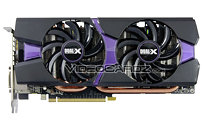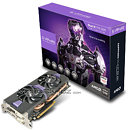More likely a 280/280x replacement.
Should be more along the 770/780 performance...
I guess it depends how much 256bit limits it and how much gcn2 tweaks help it...
It's not the fact 256-bit limits it so much, it's the fact 5500mhz limits it, unless there is some arch difference we don't know about. There's quite a spread from 5500mhz to what potentially 7ghz (overclocked) could achieve, as this will likely be limited purely by bandwidth capable (or power allowance restraining clockspeed) because of ram/placement in the stack choice. It would not necessarily be the bottleneck if the ram was faster (to a point...think something like 1792sp @ 1111mhz/7000, similar to 680 would work fine, or proportionally how high 7ghz could scale, and as such core clock could as well).
5500mhz (with corresponding stream processor/clock to match it) puts it squarely against the 760. That's just math:
5500mhz is around enough for 1536sp at 1018mhz or 873mhz with 1792. I think the likely scenario is the former, but it could be the later, certainly (and hopefully). The later would be more efficient, but clockspeed of 918mhz (base clock?) makes me think the former...but sometimes amd clocks their chips a little higher to make up optimal texture rate etc differences, so it's possible it's 1792 even if 918mhz boost clock. We'll know soon enough.
Just taking that (baseline, assuming similar to past GCN products) and comparing it to 760:
1018*1536/1344 = 1164mhz, if both have close to perfect bandwidth/flop.
(*760 is 6*192sp+32sfu = similar to 1344sp when not limited by compute)
At that clock 760 would need around 4715mhz ram clock, but it has a base of 6000.
6000/4715 = 1.2725
.2725*.16 = 1.0436 (approx added performance for extra bw)
1164/1.0436 = 760 @ 1116/6000 ~= 285 @ aprox optimal flops/5500mhz @ 256-bit.
A 760 generally boosts to around that level during normal operation.
So, essentially (granted things vary based on where a bottleneck is in a scenario) they should be similar, especially if amd clocks their core slightly above optimal to even out some advantages nvidia has per flop/clock, and obviously in compute heavy scenarios will be superior.
Doesn't matter if it's 1792 or 1536sp though, really. What matters (I suppose) is max bandwidth and the maximum power allowed by powertune; where amd wants it to perform overall vs other products. I can't imagine it going much higher than something like 1185/6400 (given where 6ghz ram often craps out) if 1536sp or relatively lower if 1792sp...either way that's (overall) very similar to how an overclocked 760 would perform (at something like 1300/6400). It could be slightly faster if the ram scales higher, and amd allows high-enough voltage tweaking/power consumption (the former being more important if less shaders) etc, but I wouldn't get my hopes up far past a fairly similar part unless there is some dramatic architecture revelation we don't know yet.









